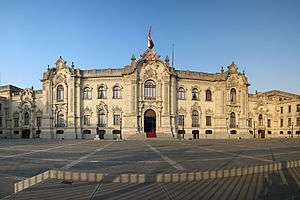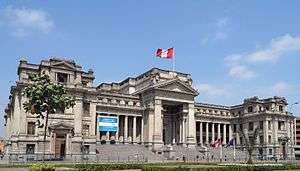Politics of Peru
 |
|---|
| This article is part of a series on the politics and government of Peru |
| Constitution |
|
President Duberlí Rodríguez
• Superior Courts of Justice • Courts of First Instance • Courts of Peace |
|
Autonomies
|
The politics of the Republic of Peru takes place in a framework of a unitary semi-presidential representative democratic republic,[1][2] whereby the President of Peru is both head of state and head of government, and of a pluriform multi-party system. Executive power is exercised by the President and the Government. Legislative power is vested in both the Government and the Congress. The Judiciary is independent of the executive and the legislature. The Economist Intelligence Unit has rated Peru as "flawed democracy" in 2016.[3]
Democratic reform
The Republic of Peru is in a state of ongoing democratization. Led by President Pedro Pablo Kuczynski, the new government is expected to be transparent and accountable.[4] Previously a rubberstamp body, Peru's unicameral Congress is emerging as a strong counterbalance to the once-dominant executive branch, with increased oversight and investigative powers. The executive branch and Congress are attempting to reform the judicial branch, antiquated and rife with corruption.
During the government of Fujimori the 1979 Constitution was changed after the Fujimori's self-coup where the president dissolved the Congress and established the new 1993 Constitution. One of the changes to the 1979 Constitution was the possibility of the president's immediate reelection (112 article) which made possible the reelection of Fujimori in the next years. After the Fujimori era and Fujimori's resign, the transition government of Valentín Paniagua changed the article 112 and called new elections in 2001 where Alejandro Toledo was elected. After that, Peru has had all presidents democratically elected.
Executive branch
| Office | Name | Party | Since |
|---|---|---|---|
| President | Martín Vizcarra | Independent | 23 March 2018 |
| First Vice President | Mercedes Aráoz | Peruvians for Change | 23 March 2018 |
| Second Vice President | Vacant | 23 March 2018 | |
| Prime Minister | César Villanueva | Independent | 2 April 2018 |
Under the current constitution, the President is the head of state and government; he or she is elected for a five-year term and may not immediately be re-elected.[5] All citizens above the age of eighteen are entitled and in fact compelled to vote. The first and second vice presidents also are popularly elected but have no constitutional functions unless the president is unable to discharge his duties.
The President appoints the Prime Minister (Primer Ministro) and the Council of Ministers (Consejo de Ministros, or Cabinet), which is individually and collectively responsible both to the president and the legislature.[1][2] All presidential decree laws or draft bills sent to Congress must be approved by the Council of Ministers.
Legislative branch
The legislative branch consists of a unicameral Congress (Congreso) of 130 members. elected for a five-year term by proportional representation In addition to passing laws, Congress ratifies treaties, authorizes government loans, and approves the government budget. The president has the power to block legislation with which the executive branch does not agree.
Political parties and elections
| Candidates – Parties | 1st round | 2nd round | |||
|---|---|---|---|---|---|
| Votes | % | Votes | % | ||
| Ollanta Humala – Peru Wins (Gana Perú) | 4,643,064 | 31.699 | 7,937,704 | 51.449 | |
| Keiko Fujimori – Force 2011 (Fuerza 2011) | 3,449,595 | 23.551 | 7,490,647 | 48.551 | |
| Pedro Pablo Kuczynski – Alliance for the Great Change (Alianza por el Gran Cambio) | 2,711,450 | 18.512 | |||
| Alejandro Toledo – Possible Peru (Perú Posible) | 2,289,561 | 15.631 | |||
| Luis Castañeda – National Solidarity (Solidaridad Nacional) | 1,440,143 | 9.832 | |||
| José Ñique de la Puente – Fonavist Party (Partido Fonavista del Perú) | 37,011 | 0.253 | |||
| Ricardo Noriega – National Awakening Party (Partido Despertar Nacional) | 21,574 | 0.147 | |||
| Rafael Belaúnde Aubry – Forward Party (Partido Político Adelante) | 17,301 | 0.118 | |||
| Juliana Reymer – National Force Party (Partido Fuerza Nacional) | 16,831 | 0.115 | |||
| Humberto Pinazo – Justice, Technology, Ecology (Justicia, Tecnología, Ecología) | 11,275 | 0.077 | |||
| Total valid (turnout %) | 14,074,682 | 100.000 | 15,428,351 | 100.000 | |
| Blank votes | 1,406,998 | 8.855 | 116,335 | 0.706 | |
| Invalid votes | 416,026 | 2.620 | 921,711 | 5.598 | |
| Source: National Office of Electoral Processes (ONPE), National Office of Electoral Processes (ONPE) | |||||
| Parties | Congress | Andean Parliament | |||||
|---|---|---|---|---|---|---|---|
| Votes | % (Valid) | Seats | Votes | % (Valid) | Seats | ||
| Peru Wins (Gana Perú) dominated by Peruvian Nationalist Party (Partido Nacionalista Peruano)
|
3,245,003 | 25.274 | 47 | 2,740,106 | 27.022 | 2 | |
Force 2011 (Fuerza 2011)
|
2,948,781 | 22.967 | 37 | 2,353,660 | 23.211 | 1 | |
Electoral Alliance Possible Peru (Alianza Electoral Perú Posible)
|
1,904,180 | 14.831 | 21 | 1,498,783 | 14.780 | 1 | |
Alliance for the Great Change (Alianza por el Gran Cambio)
|
1,851,080 | 14.417 | 12 | 1,413,783 | 13.942 | 1 | |
National Solidarity Alliance (Alianza Solidaridad Nacional)
|
1,311,766 | 10.217 | 9 | 954,618 | 9.414 | 0 | |
| American Popular Revolutionary Alliance (Partido Aprista Peruano) | 825,030 | 6.426 | 4 | 638,675 | 6.298 | 0 | |
| Radical Change (Cambio Radical) | 347,475 | 2.706 | 0 | 195,441 | 1.927 | 0 | |
| Fonavist Party (Fonavistas des Perú) | 170,052 | 1.324 | 0 | 158,877 | 1.567 | 0 | |
| Decentralist Party Social Force (Partido Decentralista Fuerza Social) | 108,200 | 0.843 | 0 | 65,265 | 0.644 | 0 | |
| Forward Party (Partido Político Adelante) | 42,276 | 0.329 | 0 | 36,193 | 0.357 | 0 | |
| National Force Party (Partido Fuerza Nacional) | 37,633 | 0.293 | 0 | 35,014 | 0.345 | 0 | |
| National Awakening Party (Partido Despertar Nacional) | 30,190 | 0.235 | 0 | — | — | — | |
| Justice, Technology, Ecology (Justicia, Tecnologia, Ecologia) | 17,478 | 0.136 | 0 | 49,869 | 0.492 | 0 | |
| Valid votes | 12,839,144 | 100.000 | 130 | 10,140,284 | 100.000 | 5 | |
| Blank votes | 4,352,212 | 26.056 | |||||
| Invalid votes | 2,210,919 | 13.236 | |||||
| Source: National Office of Electoral Processes - on Congressional Election | |||||||
Judicial branch
The judicial branch of government is headed by a 16-member Supreme Court seated in Lima. The National Council of the Judiciary appoints judges to this court.
The Constitutional Court (Tribunal Constitucional) interprets the constitution on matters of individual rights. Superior courts in regional capitals review appeals from decisions by lower courts. Courts of first instance are located in provincial capitals and are divided into civil, penal, and special chambers. The judiciary has created several temporary specialized courts in an attempt to reduce the large backlog of cases pending final court action.
Peru's legal system is based on civil law system. Peru has not accepted compulsory ICJ jurisdiction. In 1996 a human rights ombudsman's office (defensor del pueblo) was created to address human rights issues.
Administrative divisions
Peru's territory, according to the Regionalization Law which was passed on 18 November 2002, is divided into 25 regions (regiones). These regions are subdivided into provinces, which are composed of districts. There are a total of 180 provinces and 1747 districts in Peru.
Lima Province is not part of any political region.
Political pressure groups and leaders
Leftist guerrilla groups include Shining Path Abimael Guzmán (imprisoned), Gabriel Macario (top leader at-large); Túpac Amaru Revolutionary Movement or MRTA Victor Polay (imprisoned), Hugo Avellaneda Valdez (top leader at-large). Both Shining Path & MRTA are considered terrorist organizations.
Non-governmental organizations
In the early 1970s and 1980s many grass-roots organizations emerged in Peru. They were concerned with problems of local people and poverty reduction. After 2000 they played an important role in the decentralisation process. Their hope was that power would be divided clearly between national and local governments and the latter would be able to address social justice and the concerns of local people better than the national government could. Some NGO-members even became part of local governments. There is debate extent to which this engagement in politics contributes to the attainment of their original goals.[6]
International organization participation
Peru or Peruvian organizations participate in the following international organizations:
- Asia-Pacific Economic Cooperation (APEC)
- Andean Community of Nations (CAN)
- Food and Agriculture Organization (FAO)
- Group of Fifteen (G-15)
- Group of Twenty-Four (G-24)
- Group of 77 (G-77)
- Inter-American Development Bank (IADB)
- International Atomic Energy Agency (IAEA)
- International Bank for Reconstruction and Development (IBRD, part of the World Bank Group)
- International Civil Aviation Organization (ICAO)
- International Criminal Court (ICC)
- International Chamber of Commerce (ICC)
- International Confederation of Free Trade Unions (ICFTU)
- International Red Cross
- International Development Association (IDA)
- International Fund for Agricultural Development (IFAD)
- International Finance Corporation (IFC)
- International Federation of Red Cross and Red Crescent Societies (IFRCS)
- International Hydrographic Organization (IHO)
- International Labour Organization (ILO)
- International Monetary Fund, (IMF)
- International Maritime Organization (IMO)
- Interpol
- IOC
- International Organization for Migration (IOM)
- International Organization for Standardization (ISO) (correspondent)
- International Telecommunication Union (ITU)
- Latin American Economic System (LAES)
- Latin American Integration Association (LAIA)
- United Nations Organization Mission in the Democratic Republic of the Congo (MONUC)
- Non-Aligned Movement (NAM)
- OAS
- Agency for the Prohibition of Nuclear Weapons in Latin America and the Caribbean (OPANAL)
- Organisation for the Prohibition of Chemical Weapons (OPCW)
- Permanent Court of Arbitration (PCA)
- Rio Group (RG)
- Union of South American Nations(Unasul-Unasur)
- United Nations
- United Nations Conference on Trade and Development (UNCTAD)
- United Nations Educational, Scientific, and Cultural Organization (UNESCO)
- UNHRC United Nations Human Rights Council (UNHRC)
- United Nations Industrial Development Organization (UNIDO)
- United Nations Mission in Ethiopia and Eritrea (UNMEE)
- United Nations Mission in Liberia (UNMIL)
- Universal Postal Union (UPU)
- World Confederation of Labour (WCL)
- World Customs Organization (WCO)
- World Federation of Trade Unions (WFTU)
- World Health Organization (WHO)
- World Intellectual Property Organization (WIPO)
- World Meteorological Organization (WMO)
- World Tourism Organization (WToO)
- World Trade Organization (WTrO)
See also
References
- 1 2 Shugart, Matthew Søberg (September 2005). "Semi-Presidential Systems: Dual Executive and Mixed Authority Patterns" (PDF). Graduate School of International Relations and Pacific Studies. United States: University of California, San Diego. Archived from the original (PDF) on 19 August 2008. Retrieved 31 August 2017.
- 1 2 Shugart, Matthew Søberg (December 2005). "Semi-Presidential Systems: Dual Executive And Mixed Authority Patterns" (PDF). French Politics. Palgrave Macmillan UK. 3 (3): 323–351. doi:10.1057/palgrave.fp.8200087. ISSN 1476-3427. OCLC 6895745903. Retrieved 31 August 2017.
Only in Latin America have all new democracies retained a pure presidential form, except for Peru (president-parliamentary) and Bolivia (assembly-independent).
- ↑ solutions, EIU digital. "Democracy Index 2016 - The Economist Intelligence Unit". www.eiu.com. Retrieved 2017-11-30.
- ↑ "Peru's president doesn't haveroom for failure". miamiherald.com.
- ↑ Constitución Política del Perú, Article No. 112.
- ↑ Monika Huber, Wolfgang Kaiser (February 2013). "Mixed Feelings". dandc.eu.
External links
| Wikimedia Commons has media related to Politics of Peru. |



.svg.png)